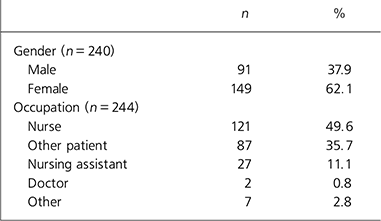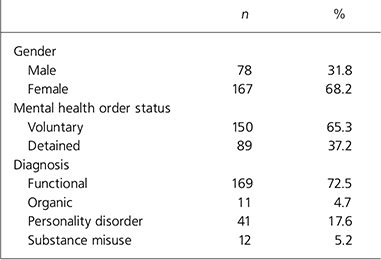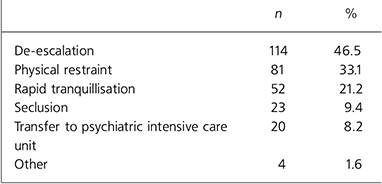Assaultive behaviour within healthcare settings has increased in frequency in recent years, 1 which has led to the development of a range of national strategies aimed at reducing such violence, such as The NHS Zero Tolerance Policy 2 and the formation of the NHS Security Management Service 3,4 in 2003. Violence against mental health personnel is a significant problem, with mental health nurses being the most frequent targets of patient-staff assaults. Reference Temple5–Reference Noble and Rodger8 Much research has focused on the prediction and management of aggression, with relatively little attention paid to the systematic reporting of assaults to the police or prosecution of assailants. Reference Coyne9 Referral to the criminal justice system of mentally disordered offenders has been a contentious issue, Reference Bayney and Ikkos10 particularly where individuals are deemed to lack responsibility for their actions. Reference Eastman and Mullins11 Nevertheless, adopting the assumption that all psychiatric patients who commit offences lack responsibility and should therefore be exempt from prosecution, lends itself to apparent justification of such behaviour in the eyes of the public, Reference Turnball, Turnball and Patterson12 undermines staff Reference Miller and Maier13 and does little to facilitate prediction of further violent acts. Reference Mullen14
Method
The primary aim of this study was to determine how often prosecution is attempted after violent incidents in acute psychiatric units. Secondary aims were to determine how often other responses to such incidents were being utilised and what factors influenced the decision-making process.
Acute adult psychiatric in-patient units in three Northern Ireland hospitals were examined – Holywell Hospital, the Tyrone and Fermanagh Hospital, and Craigavon Area Hospital. Both psychiatric intensive care units and general adult wards were surveyed in the former two hospitals, but as Craigavon Area does not have a psychiatric intensive care unit, only incidents in the general adult wards were examined here. It was decided to examine incidents that occurred in the calendar year 2003, to allow sufficient time for any ensuing legal proceedings to be completed.
For this study, assault was defined as a physical attack involving actual contact with another person. This is quite different to the legal meaning of the word, but more closely resembles the definition of physical assault by the NHS Security Management Service 3 (‘the intentional application of force to the person of another, without lawful justification, resulting in physical injury or personal discomfort’) and the legal concept of battery. This definition was used as this type of incident was more likely to be reported by staff, and the nature of the incident would be less ambiguous. Incidents were identified from a computerised database (DATIX) and the relevant original incident forms were then examined using the same checklist at each site, which detailed sociodemographic details and information on the assault, assailant and victim. In the event of police being contacted, case notes were examined. ICD–10 15 diagnoses were gathered from another database (ePEX–3), these being based on the judgement of the treating psychiatrist. The term ‘major mental illness’ is used to denote all individuals afforded a diagnosis of affective or psychotic illness not believed to be organic in origin. Data were analysed using SPSS (Statistical Package for Social Sciences) version 12.0.1 for Windows.
Results
Incidents
A total of 245 incidents of assault were recorded for the three sites: Holywell Hospital 82 (33.5%), Tyrone and Fermanagh Hospital 88 (35.9%) and Craigavon Area Hospital 75 (30.6%). In total, 110 people were responsible for 245 incidents of assault. Seven individuals accounted for 57 (30.4%) of all assaults. Of these, three people had a psychotic illness, two had a primary diagnosis of a personality disorder, one had a depressive illness and one had bipolar affective disorder. The setting was a general psychiatric ward for 67.3%, the remainder occurring in psychiatric intensive care units. The mean age of the victim was 39.2 years and the mean age of assailant was 39.9 years. Victim and assailant characteristics are outlined in Tables 1 and 2.
Table 1. Victim characteristics

| n | % | |
|---|---|---|
| Gender (n = 240) | ||
| Male | 91 | 37.9 |
| Female | 149 | 62.1 |
| Occupation (n = 244) | ||
| Nurse | 121 | 49.6 |
| Other patient | 87 | 35.7 |
| Nursing assistant | 27 | 11.1 |
| Doctor | 2 | 0.8 |
| Other | 7 | 2.8 |
Table 2. Assailant characteristics

| n | % | |
|---|---|---|
| Gender | ||
| Male | 78 | 31.8 |
| Female | 167 | 68.2 |
| Mental health order status | ||
| Voluntary | 150 | 65.3 |
| Detained | 89 | 37.2 |
| Diagnosis | ||
| Functional | 169 | 72.5 |
| Organic | 11 | 4.7 |
| Personality disorder | 41 | 17.6 |
| Substance misuse | 12 | 5.2 |
The majority of incidents occurred between 8.00 and 20.00 h (n = 169, 69.0%). There was an excess of incidents on Mondays n = 42, 17.1%) and Fridays (n = 44, 18.0%) with the least number of incidents occurring on Thursdays (n = 19, 7.8%). More than two-thirds of all incidents occurred during the winter and spring months (n = 159, 64.9%).
Minor injuries only were sustained in 29.8% of reported incidents, with 13.5% of victims requiring first-aid treatment, 1.2% requiring hospital treatment and the remainder advised to attend either occupational health or their general practitioner. No injuries were sustained in 70.2% of reported incidents.
Response
Immediate responses are outlined in Table 3. More than one response was used on a number of occasions. Seclusion was only available in psychiatric intensive care unit settings.
Table 3. Immediate responses

| n | % | |
|---|---|---|
| De-escalation | 114 | 46.5 |
| Physical restraint | 81 | 33.1 |
| Rapid tranquillisation | 52 | 21.2 |
| Seclusion | 23 | 9.4 |
| Transfer to psychiatric intensive care unit | 20 | 8.2 |
| Other | 4 | 1.6 |
Physical restraint was used more often when the assailant was male compared with female (43.6% v. 28.1%, P = 0.017), where injury was sustained (42.5% v. 29.1%, P = 0.041) and where the victim was a staff member rather than another in-patient (39.7% v. 21.8%, P = 0.005). Similarly, rapid tranquillisation was more frequently used when the victim was a member of staff rather than a patient (28.5% v. 9.2%, P = 0.00).
Detained individuals were more likely to be secluded than voluntary in-patients (30.2% v. 5.9%, Pearson's chi-squared P = 0.04). Detained individuals were also more likely to be restrained; however, this did not reach statistical significance (P = 0.053).
The use of transfer to a psychiatric intensive care unit varied significantly between sites, with Holywell, and Tyrone and Fermanagh Hospitals (29.6% and 12.0% respectively) transferring more frequently than Craigavon Area Hospital (6.8%) (chi-square P = 0.006). The difference in rates of transfer could however be partly explained by the onsite location of psychiatric intensive care units in the former two hospitals.
Police involvement
In 10/245 (4%) incidents, the police were contacted by telephone. Police involvement was instigated by another in-patient in three of these cases and by ward staff in seven. Three of the ten contacts resulted in a police interview. This resulted in two police cautions and one transfer to a medium secure unit pending prosecution. Of ten incidents where police were involved, seven of the assailants were detained, five were female and six had a diagnosis of major mental illness. Where the assault resulted in police involvement, 6/10 (60%) of victims were female, 5/10 (50%) were nurses, 4/10 (40%) sustained an injury and 2/10 (20%) required first aid. Of these cases, 2/10 assailants required de-escalation alone, 6/10 were restrained, and 2/10 received rapid tranquilisation. Two assailants were transferred to a more secure environment.
Discussion
Our study demonstrates that there exists a very real threat to staff and patients alike of physical assault by psychiatric in-patients. It also demonstrates the infrequent reporting to the police of such assaults. Our findings show that prosecution is rarely undertaken as an option after physical assault. Few cases were referred to the police, culminating in one prosecution only.
In our study a small number of individuals were responsible for a disproportionate number of assaults, which replicates earlier findings. Reference Eastman and Mullins11 Adequate and timely identification of clusters offers an opportunity to predict further incidents. We found a female preponderance of both victim and assailant, with perpetrators more likely to assault someone of the same gender, although this may be explained by the presence of same-gender wards and the gender mix of staff on these wards. Reference Convit, Isay, Otis and Volavka16 Previous studies have found women in hospital settings to be more frequently involved in violent incidents than their male counterparts, but that men are more likely to cause injury. Reference Davison17 As evident from earlier studies, staff members were more likely than patients to be victims of assault, with doctors being assaulted least frequently. This could be a reflection of the perceived status of the doctor. Reference Coyne9,Reference Convit, Isay, Otis and Volavka16 It is also interesting that a majority (72.5%) of assailants were diagnosed with a major mental illness, and only 16.7% were given a primary diagnosis of personality disorder. Although it is well recognised that certain mental disorders increase the risk of violence, higher rates of violence have been established most prominently for individuals with a diagnosis of substance misuse, followed by cluster B personality disorders, and to a lesser extent, schizophrenia-spectrum disorders. Reference Johnson, Cohen, Smailes, Kasen, Oldham and Skodol18–Reference Arsenault, Moffitt, Avshalom, Taylor and Silva20
Limited consideration however has been given to involvement of the police or criminal justice system, where appropriate, as a means of deterring or reducing violence in psychiatric in-patient facilities. Arguments in favour of prosecution include making assailants responsible for their actions, facilitating future clinical risk assessment, ensuring safety of other in-patients and staff, and reducing the perception that violence is an occupational hazard. However, unless used appropriately, where it is believed to be of benefit to the individual themselves, the victim and those thought to be at risk of further assault, prosecution may serve to further alienate the individual and compromise the therapeutic alliance. The issue of capacity further complicates the decision whether or not to prosecute. However, it must be borne in mind that mental disorder and capacity are not mutually exclusive concepts. It should not be presumed that the assailants’ presence on the ward itself exempts them from police involvement or indeed prosecution. Secretary of State directions require that all incidents of physical assault be reported – whether intentional or not. 21 Exceptions can be made where following discussion with all relevant staff, it is clear that the assault was not intentional, the individual did not know what they were doing, or did not know that what they were doing was wrong, as a result of the nature of their mental ill health or the medication administered to treat such a condition. Decisions on intent and subsequent legal action should rest with an investigative body and ultimately the courts, and not with either the victim or the NHS organisation.
It is reasonable to suggest that given the multiplicity of variables that should be considered when deciding whether or not to prosecute, each incident should be evaluated on its own merits by clinicians not directly responsible for the individual's care and in close corroboration with our colleagues in the criminal justice system. Our study demonstrates low levels of reporting to the police of violent assaults in in-patient psychiatric units, probably reflecting underreporting of such assaults. It also highlights a division between the mental health service and the criminal justice system.
The NHS Zero Tolerance campaign and the more recent development of the NHS Security Management Service would appear to have successfully raised awareness both at local and national levels in relation to violence within healthcare settings. Promoting Safer and Therapeutic Services, which outlines the new national syllabus for the prevention and management of violence in mental health and learning disability services, is welcomed. 4 Although efforts are ongoing in terms of meeting national syllabus standards in terms of physical and non-physical intervention training, the existence of a consistent approach in dealing with violent acts perpetrated by psychiatric in-patients is not transparent.
We propose the development of standardised protocols, policies and procedures for the reporting of violent incidents in psychiatric in-patient facilities across Northern Ireland, supported by a collaborative inter-agency approach to the decision-making process of whether or not to proceed with prosecution. This process may facilitate increased reporting and indeed organisational support for staff in doing so, thereby demonstrating to staff that they are valued, and impressing upon capacitous assailants that assaults will be taken seriously.
Limitations of the study
The main weakness of this study is that the number of assaults leading to prosecution was so small that the reasons behind the decision to prosecute could not be elucidated. A secondary finding was the lack of a consistent approach across sites in both the recording of incidents of assault and the lack of communication and information sharing across agency boundaries. As a result, potentially useful information in terms of the mental state of the individual at the time of assault was unavailable and therefore questions surrounding capacity remained unanswered. The fact that diagnoses of individuals perpetrating assaults were not based on structured interviews, but on the judgement of the treating psychiatrist, precluded the drawing of any meaningful conclusions about the relationship between assaultive behaviour and diagnosis.
Declaration of interest
None.






eLetters
No eLetters have been published for this article.